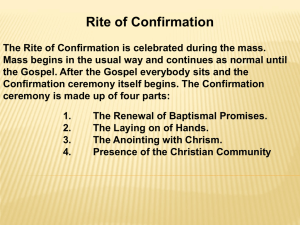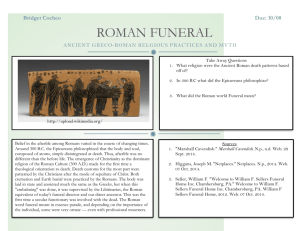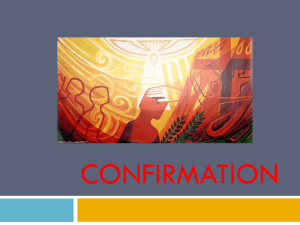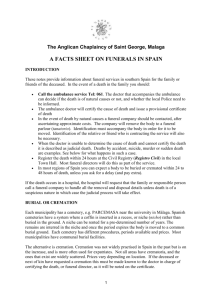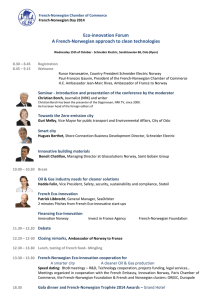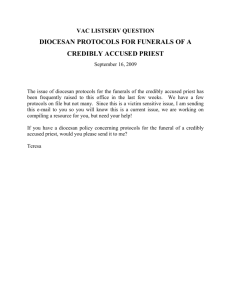Life rituals in Norway FROM PREGNANCY
advertisement
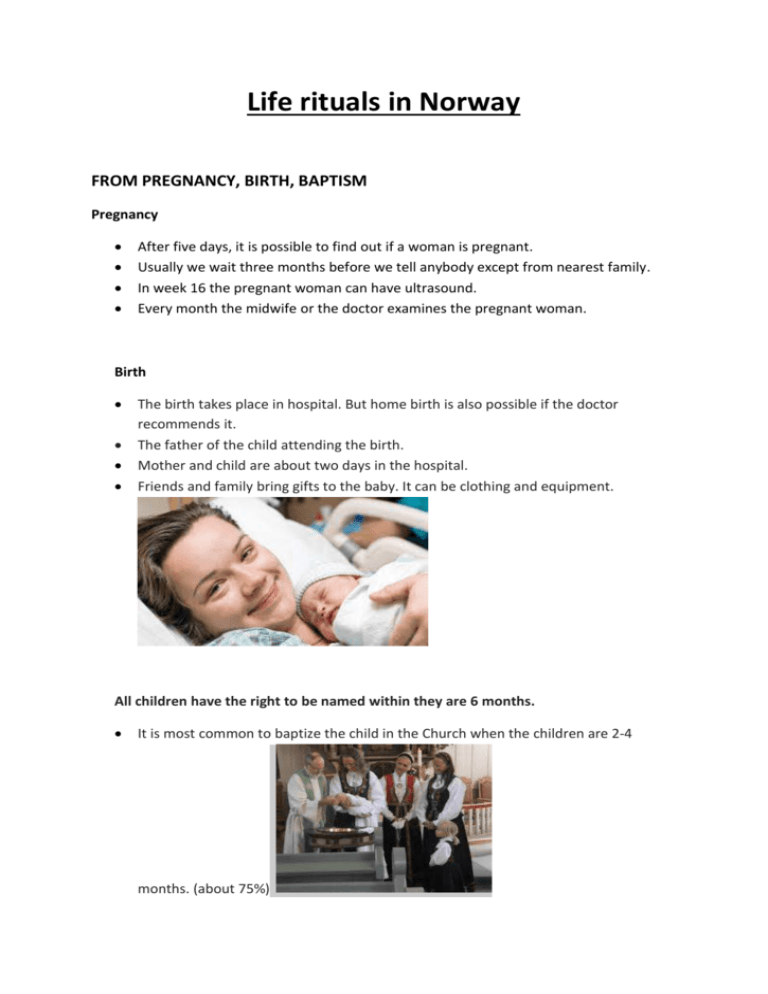
Life rituals in Norway FROM PREGNANCY, BIRTH, BAPTISM Pregnancy After five days, it is possible to find out if a woman is pregnant. Usually we wait three months before we tell anybody except from nearest family. In week 16 the pregnant woman can have ultrasound. Every month the midwife or the doctor examines the pregnant woman. Birth The birth takes place in hospital. But home birth is also possible if the doctor recommends it. The father of the child attending the birth. Mother and child are about two days in the hospital. Friends and family bring gifts to the baby. It can be clothing and equipment. All children have the right to be named within they are 6 months. It is most common to baptize the child in the Church when the children are 2-4 months. (about 75%) The child is dressed in christening robe and carried to the baptism of the parents and godparents. Afterwards they have a party for the family of the child. Other denominations such as Baptist have adult baptism. It is becoming more common that parents want names party for their children. This is organized by the Human Ethical Union. Maternity leave In Norway the parents have about a year's leave. Parents can share the leave. Government wants the father to take a greater role in caring for the child. Most mothers breastfeed the child in 6 months. They continue to breastfeed until their child is about 12 months, but also provides additional food to breast milk from the child is 6 to 12 months. CONFIRMATION. A Christian confirmation. When the child is 14 years of age we have a celebration in church called “konfirmasjon” (confirmation) which goes back to 1736! This is for the teenager himself to confirm that he/she still wants to belong to the church and the Christian belief. First they have to learn more about the Bible, Jesus’ life, the Holy Trinity, the Christian customs and so on. They meet once a week from Sept. - May in the church, where they are taught by the community priest. They also have to attend to five church services on Sundays and participate in a confirmation camp for a weekend or more. The celebration takes part after this period of learning. Dressed in white gowns, they all sit nearby the altar on the confirmation-service. When the priest calls them by name, they come forward one at a time. The teenager kneels and receives a prayer and a blessing from the priest. Humanistic confirmation Humanistic confirmation is another way to celebrate the families teenage girl- og boy with a religious influence. Their course and ceremony have a humanistic foundation. It’s for all to choose, independent of their parent’s view of life. The purpose of humanistic confirmation is to strengthen humanistic values in society. The course is meant to strengthen the candidates’ capacity of independent thoughts and acting, according to ethical standards. The candidates will learn about: Insight in their own experiences, attitudes and behavior. Reflection and capability to ask critical questions. Consciousness about view of life. Capability of thoughtfulness, tolerance and how to take responsibility. The course usually starts in January/February and lasts to April/May. The lessons take place once a week, and each lesson lasts two hours. At the end of the course there is a ceremony for the candidates, their family and friends. During this ceremony there would be a speech and some cultural elements, such as music, poems and songs. The candidates get a diploma. The ceremony usually take place in the city hall. About 10.000 young people have chosen humanistic confirmation during the last few years. The Party After the seremony in the church\theatre\city hall, all the guests get together and celebrate the teenager at home. They have a party. All the guests are wearing nice clothes. The boys are wearing suits and the girls are wearing a dress. If the confirmand is a boy, the tablecloth usually is blue, and decorated with for instance blue candles and napkins, blue flowers etc. If the confirmand is a girl, the tablecloth is for instance pink, pink candles and so on. The family eats a nice dinner and drink wine or lemonade. Some of the gests,- aunts or grandparents, often have made a speech or a song for the conformant. The text may be about the childhood, which now is over, or the future. After dinner they drink coffee and eat a lot of delicious cakes! Some families play games and enjoy themselves! Gifts are important and the youth often gets a considerable amount of money ENGAGEMENT, WEDDING AND DIVORCE In Norway two people can choose to announce to relatives and friends that they have plans to get married. This is called an engagement. When they get engaged, they promise each other that they will get married. An engagement usually means that they will get married within a year, but people can choose to be engaged for as long as they want to. The two often put on a ring to symbolize their promise. In Norway people can choose to get married in a church by a priest or to get the marriage accepted by a judge. The couple promise to love each other and stay together for the rest of their lives. In 2009 Norway accepted marriage between the same sexes which means that two men or two women can get married. After the wedding ceremony, the wedded couple usually throw a big party for family and friends. Getting married can be very expensive. To get married out of love is a tradition in Norway, but approx. 40-50% of all marriages ends in a divorce. The main reason is that they don`t love each other any more. Other reasons can be infidelity, violence or economic reasons. FUNERALS IN NORWAY When a person dies, the family and friends are filled with grief. To help process this grief the family honors the deceased. There are two kinds of funerals in Norway – one is a Christian tradition and the other is organized by The Norwegian Humanist Association. The Christian Funeral: In church the family and next of kin will tell something from the deceased life – what they accomplished and where they lived. There will be singing, and the priest will read from the Bible and talk about death and the life after death. Often family and friends decorate the coffin with flowers. Some from the closest family or closest friend with carry the coffin outside and to the designated grave. By the grave there is normally a hymn sung before the coffin is slowly lowered into the ground. The grave is then marked by a, often decorated, gravestone – often inscribed with a word from the bible or other phrases of love. Someone wish to be cremated instead. In that case the family often brings the urn with ashes back home with them after the funeral. The Norwegian Humanist Association Funeral: This nonreligious funeral takes place in a public room with no religious artwork. There are no nonreligious cemeteries in Norway, so most people that choose this kind of funeral choose to cremate the deceased. Those who do not wish to be cremated are buried at the Christian cemetery. Some of those who choose cremation wish for their ashes to be spread somewhere they feel connected to. This could be in a special forest, at sea or by a lake. The permission for this is granted by the local government. The funeral is very like the Christian funeral with speeches and songs. Either if the family chose a Christian funeral or a funeral by the Norwegian Humanist Association a funeral in Norway is for the family to remember and honor the deceased.
